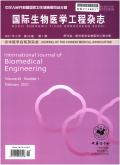Clinical observation on the treatment of cervical spondylotic radiculopathy by the pulsed radiofrequency combined with the fixed-point lateral flexion and rotation realignment cervical manipulation
引用次数: 0
Abstract
Objective To observe the clinical efficacy of pulsed radiofrequency combined with fixed-point lateral flexion and rotation realignment cervical manipulation in the treatment of cervical spondylotic radiculopathy (CSR). Methods Sixty-three patients with CSR were randomly divided into observation group (n=32) and control group (n=31). The observation group was given pulse radiofrequency combined with fixed-point lateral flexion and rotation realignment cervical manipulation, and the control group was given the pulsed radiofrequency treatment. Visual analog scale (VAS) and Japanese Orthopaedic Association (JOA) scores were obtained before the treatment, 7 days and 3 months after the treatment. The temperature differences of bilateral upper limbs infrared thermal imaging were observed before and 3 months after the treatment in the two groups. The clinical efficacy of the two groups was evaluated by using TCM disease and syndrome diagnosis criteria. Results After 7 days and 3 months of the treatment, the VAS scores of the two groups were lower than those before treatments, the VAS scores of the observation group were lower than the control group, and all the differences were statistically significant (all P 0.05]. Three months after the treatment, the temperature difference of infrared thermography in the upper limbs of the observation group was better than that of the control group (P 0.05). Conclusions The pulsed radiofrequency combined with the fixed-point lateral flexion and rotation realignment cervical manipulation in the treatment of radiculopathic cervical spondylosis was effective in improving pain, function and infrared imaging temperature of upper limbs. Key words: Cervical spondylotic radiculopathy; Pulsed radiofrequency surgery; Fixed-point lateral flexion and rotation realignment cervical manipulation; Treatment Outcome脉冲射频配合定点侧屈旋转复位颈椎手法治疗神经根型颈椎病的临床观察
目的观察脉冲射频联合定点侧屈旋转复位颈椎手法治疗神经根型颈椎病的临床疗效。方法将63例CSR患者随机分为观察组(n=32)和对照组(n=31)。观察组采用脉冲射频联合定点侧屈旋转复位颈椎手法治疗,对照组采用脉冲高频治疗。在治疗前、治疗后7天和3个月获得视觉模拟量表(VAS)和日本骨科协会(JOA)评分。观察两组患者治疗前和治疗后3个月双侧上肢红外热像图的温度差异。采用中医证候诊断标准对两组患者的临床疗效进行评价。结果治疗7天3个月后,两组VAS评分均低于治疗前,观察组VAS评分低于对照组,治疗后3个月,观察组上肢红外热像图温差明显好于对照组(P<0.05)治疗神经根型颈椎病对改善上肢疼痛、功能及红外成像温度有明显疗效。关键词:神经根型颈椎病;脉冲射频手术;定点侧屈旋转复位颈椎手法;治疗结果
本文章由计算机程序翻译,如有差异,请以英文原文为准。
求助全文
约1分钟内获得全文
求助全文

 求助内容:
求助内容: 应助结果提醒方式:
应助结果提醒方式:


